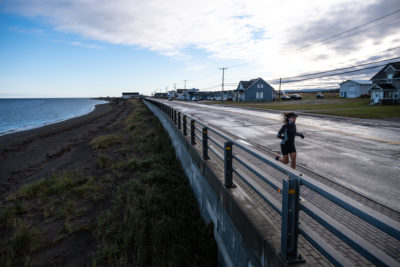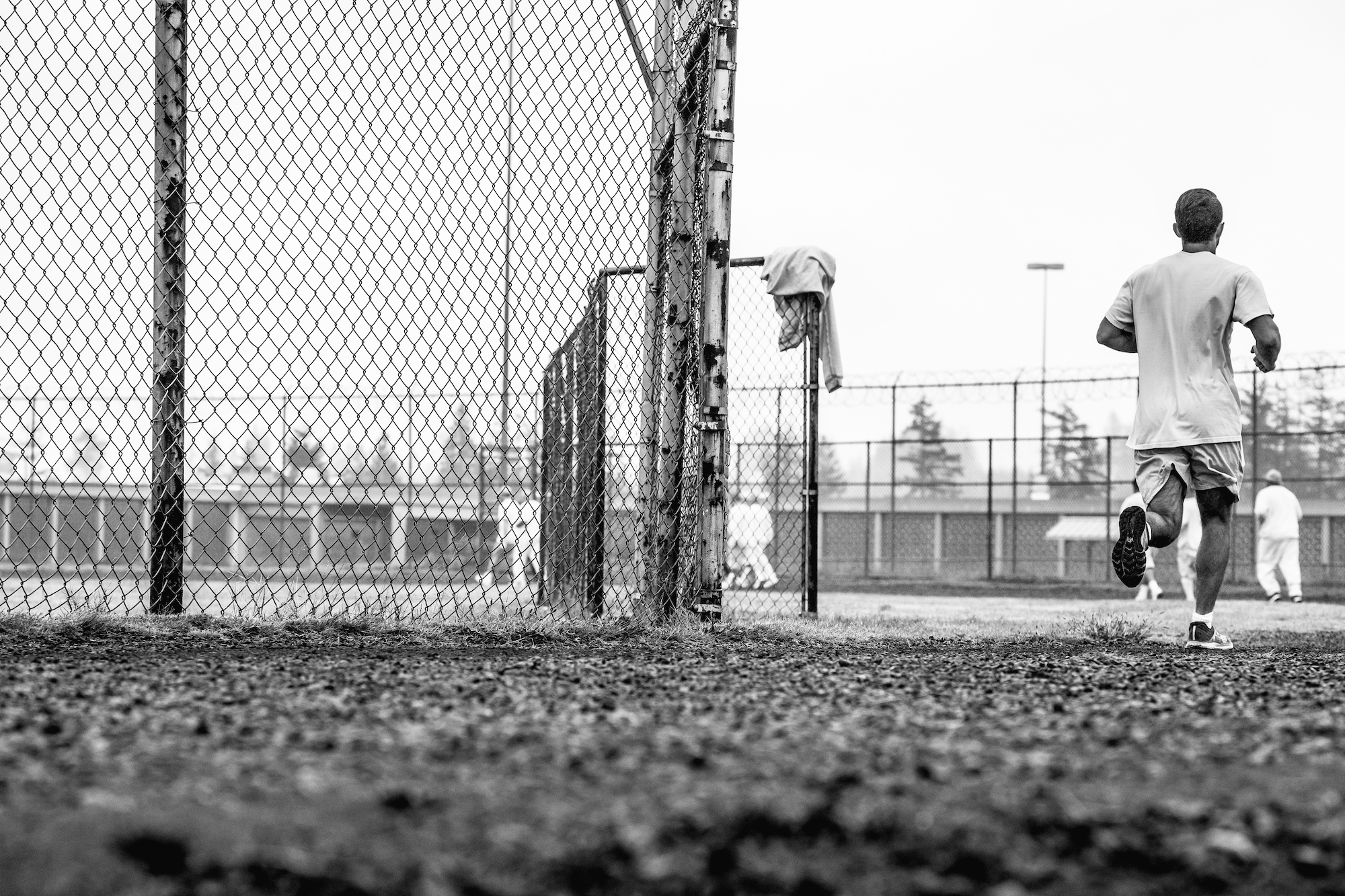
around the block
around the block
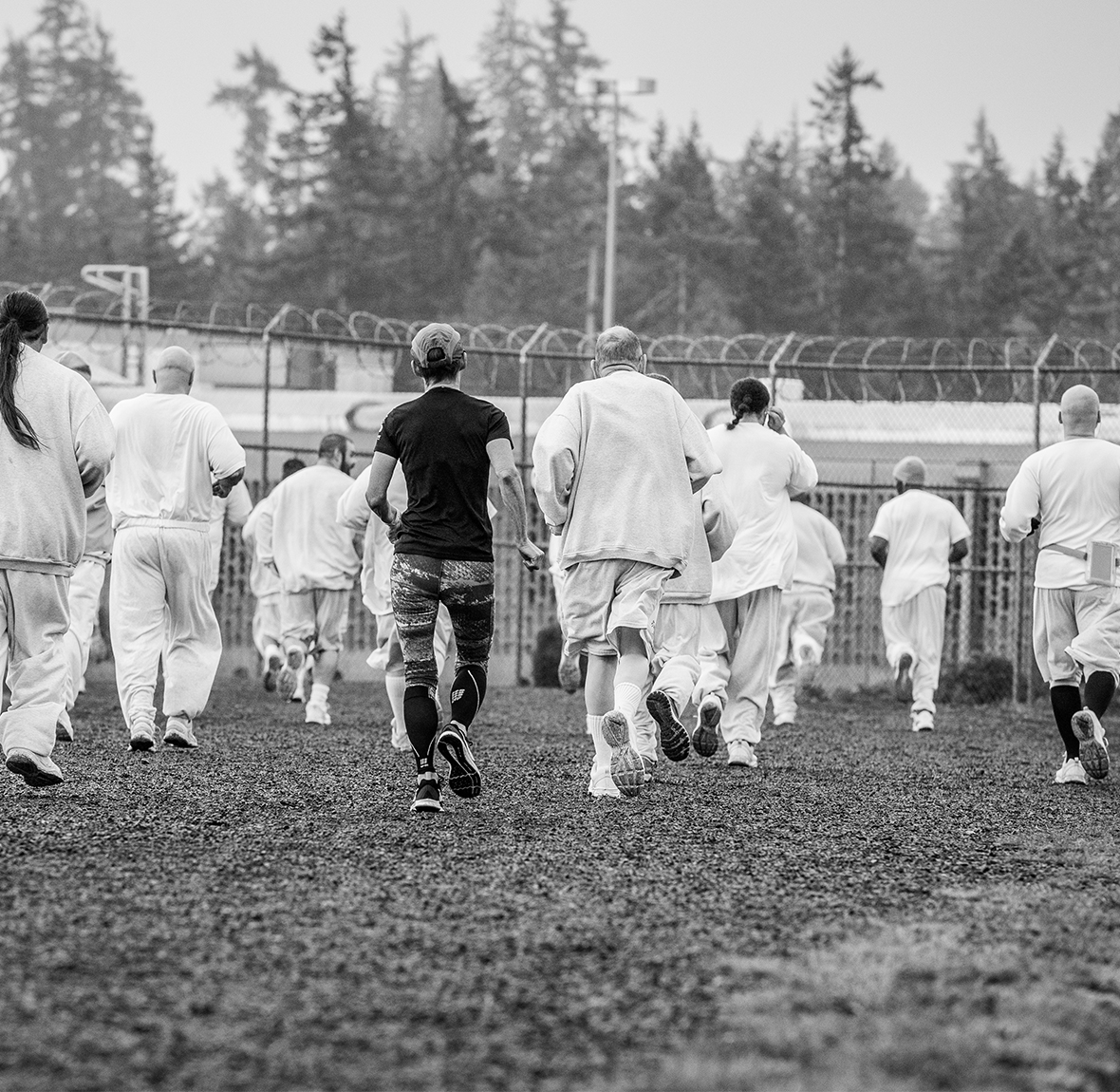
words x
anna katherine clemmons
photos x
jo arlow
this feature was co-produced with like the wind magazine and also appears in LTW#27.
—
The sunrise on 11 January 2019 emerged through a thick fog. Seagulls flew overhead as the 1,000-Mile Club coaches, volunteers and a documentary film crew entered through San Quentin State Prison’s main gates. Two birds, perched on the barbed wire coiled above the high, cream-coloured prison walls, chirped loudly as the group walked on to the prison grounds. Just out of sight beyond the perimeter, ocean waves crashed on to the shoreline.
San Quentin’s running track is part-dirt, part-gravel, part-concrete, a jagged 0.2-mile loop with six 90-degree turns. A full marathon comes in at 104-and-a-half laps; each lap circumferences the San Quentin baseball field and parallels a section of the basketball court.
Geese stood on the baseball diamond’s muddy outfield. At 7.30am, the runners gathered near the designated start, yawning and stretching. Some wore grey tank tops, others undershirts or no shirt in the 40°C heat. Most had running shoes, but a few men wore prison-issue shoes. A few held CD players or Walkmans with headphones.
At approximately 8am, former Army officer and volunteer coach Frank Ruona counted down to the marathon’s official start.
As each inmate began to run, his designated lap counter – a mix of volunteer coaches, inmates and run club members not participating in the marathon – shouted their lap numbers or held up their hands to indicate lap count.
“Three miles, Ishmael!” called out Jim Maloney, a tall, tanned volunteer coach and community runner. On a nearby cardboard table, one large cooler held water; the other was filled with Gatorade, donated by a local running group.
On the far side of the yard, a handful of inmates dressed in prison-blue denim sat at picnic tables, watching the runners go by. Others worked out inside a fenced-in area, counting out pull-ups or jumping rope. A few men shot hoops on the basketball court. On an adjacent concrete blacktop, one inmate, clippers in hand, gave haircuts to fellow prisoners. Writers for The San Quentin News, the prison newspaper staffed by inmates, stood at the entrance to the trailer that served as an office.
Asked if the myriad recreational activities had always been available to inmates, an older inmate, who had been imprisoned in San Quentin for 20 years, chuckled.
“The only extracurricular around here in 1989 was getting stabbed,” he replied.
—
The sunrise on 11 January 2019 emerged through a thick fog. Seagulls flew overhead as the 1,000-Mile Club coaches, volunteers and a documentary film crew entered through San Quentin State Prison’s main gates. Two birds, perched on the barbed wire coiled above the high, cream-coloured prison walls, chirped loudly as the group walked on to the prison grounds. Just out of sight beyond the perimeter, ocean waves crashed on to the shoreline.
San Quentin’s running track is part-dirt, part-gravel, part-concrete, a jagged 0.2-mile loop with six 90-degree turns. A full marathon comes in at 104-and-a-half laps; each lap circumferences the San Quentin baseball field and parallels a section of the basketball court.
Geese stood on the baseball diamond’s muddy outfield. At 7.30am, the runners gathered near the designated start, yawning and stretching. Some wore grey tank tops, others undershirts or no shirt in the 40°C heat. Most had running shoes, but a few men wore prison-issue shoes. A few held CD players or Walkmans with headphones.
At approximately 8am, former Army officer and volunteer coach Frank Ruona counted down to the marathon’s official start.
As each inmate began to run, his designated lap counter – a mix of volunteer coaches, inmates and run club members not participating in the marathon – shouted their lap numbers or held up their hands to indicate lap count.
“Three miles, Ishmael!” called out Jim Maloney, a tall, tanned volunteer coach and community runner. On a nearby cardboard table, one large cooler held water; the other was filled with Gatorade, donated by a local running group.
On the far side of the yard, a handful of inmates dressed in prison-blue denim sat at picnic tables, watching the runners go by. Others worked out inside a fenced-in area, counting out pull-ups or jumping rope. A few men shot hoops on the basketball court. On an adjacent concrete blacktop, one inmate, clippers in hand, gave haircuts to fellow prisoners. Writers for The San Quentin News, the prison newspaper staffed by inmates, stood at the entrance to the trailer that served as an office.
Asked if the myriad recreational activities had always been available to inmates, an older inmate, who had been imprisoned in San Quentin for 20 years, chuckled.
“The only extracurricular around here in 1989 was getting stabbed,” he replied.
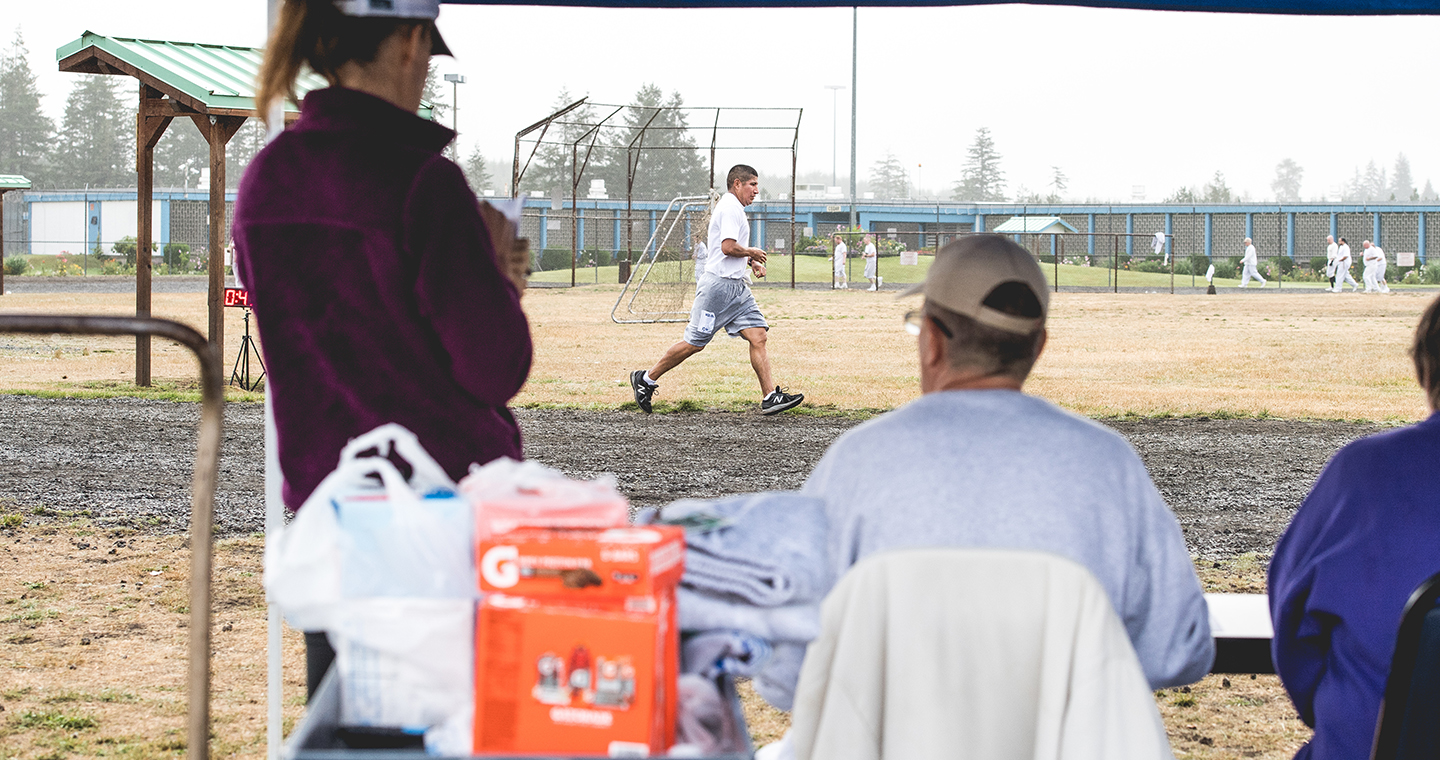
Growing up in a housing project in Fillmore, a San Francisco neighbourhood, Markelle Taylor often played “Big Man versus Little Man”. The game was simple: the neighbourhood’s older kids chased the younger kids. If the former caught the latter, they beat them up.
“We used to jump from rooftop to rooftop while trying to run away,” Taylor, now 48, says. “But no one ever caught me.”
Taylor was abused by several relatives when he was young. During his teenage years, he moved through different foster homes. He ran track and cross-country in high school, and was fast enough to earn an athletic scholarship to Foothill Junior College in Los Altos, California. But when he arrived, he started abusing alcohol and dealing drugs. He lost his scholarship, dropped out and was soon arrested for the first time.
Taylor arrived at San Quentin in 2012 – his fifth prison in 17 years – after being convicted of second-degree murder. Soon afterwards, his friend Jesse Gonzalez was denied parole for a fifth time. Gonzalez tried to take his own life by swallowing pills, but correctional officers discovered his body before he died. They placed Gonzalez in solitary confinement, where he hanged himself with a bedsheet. Taylor hadn’t run while incarcerated. But when he learned of Gonzalez’s suicide, he decided to start.
“I was due for the [parole] Board, and I thought: ‘Man, I don’t want to– ’”
Taylor, speaking inside one of San Quentin’s classrooms in 2018, stops. “When people get denied [parole], they either self-medicate through drugs or get in all kinds of trouble. That’s how it was on the street – when I had hard times.”
“We used to jump from rooftop to rooftop while trying to run away,” Taylor, now 48, says. “But no one ever caught me.”
Taylor was abused by several relatives when he was young. During his teenage years, he moved through different foster homes. He ran track and cross-country in high school, and was fast enough to earn an athletic scholarship to Foothill Junior College in Los Altos, California. But when he arrived, he started abusing alcohol and dealing drugs. He lost his scholarship, dropped out and was soon arrested for the first time.
Taylor arrived at San Quentin in 2012 – his fifth prison in 17 years – after being convicted of second-degree murder. Soon afterwards, his friend Jesse Gonzalez was denied parole for a fifth time. Gonzalez tried to take his own life by swallowing pills, but correctional officers discovered his body before he died. They placed Gonzalez in solitary confinement, where he hanged himself with a bedsheet. Taylor hadn’t run while incarcerated. But when he learned of Gonzalez’s suicide, he decided to start.
“I was due for the [parole] Board, and I thought: ‘Man, I don’t want to– ’”
Taylor, speaking inside one of San Quentin’s classrooms in 2018, stops. “When people get denied [parole], they either self-medicate through drugs or get in all kinds of trouble. That’s how it was on the street – when I had hard times.”
“I’d run to the bottle, because I was an alcoholic and I’d make bad choice after bad choice.”
Initially, Taylor ran alone in the prison yard. But then a fellow inmate told him about the 1,000-Mile Club.
Led by Frank Ruona, the 1,000-Mile Club – named for the goal that each member runs 1,000 miles while in prison – was structured like an official training group. Ruona, a veteran of 78 marathons and 38 ultra-marathons, had coached the nearby Tamalpa Runners club for several years; when a friend asked him to help with the prison running club in 2005, he reluctantly agreed.
“I was still working full-time then, and this takes time out of your day,” Ruona, now 75 and retired, says. “I thought I’d give it a try for a couple of months, and that would probably be it. But after going over there, I developed relationships with a lot of the guys in the club, and I enjoyed it.”
Initially, Taylor just watched the 1,000-Mile Club runners. He didn’t want to run at night or in the cold. But by 2014, he had joined the club, which had been given approved times to run in addition to regularly-scheduled yard time.
From his first practice, he was the fastest runner Ruona had ever coached at San Quentin.
Standing 5’10” and 160lbs, with long, thin, muscular limbs and a bow-legged stride, Taylor is quick and graceful. He glides more than jogs and his facial expressions rarely change. Running with the club made him feel empowered and liberated. It gave him self-confidence and purpose as he ran “for those who struggle,” he said.
He focused on his training, his splits, and his time goals. He began changing his dietary habits to better serve his running. And from 2015-17, Taylor won the 1,000-Mile Club’s annual marathon, held inside the prison yard each November.
He was preparing to defend his title again in 2018, and inmates started placing informal bets on whether Taylor would win for a fourth time in succession. But wildfires forced inmates indoors for almost two weeks, and the 2018 race (the 12th annual marathon) was rescheduled for mid-December. This date was also postponed, after two suicides on death row forced a prison-wide lockdown. The race was finally scheduled for 11 January 2019.
Taylor had been ill during early January, and had not been running. But the night before the marathon, he decided to participate.
Led by Frank Ruona, the 1,000-Mile Club – named for the goal that each member runs 1,000 miles while in prison – was structured like an official training group. Ruona, a veteran of 78 marathons and 38 ultra-marathons, had coached the nearby Tamalpa Runners club for several years; when a friend asked him to help with the prison running club in 2005, he reluctantly agreed.
“I was still working full-time then, and this takes time out of your day,” Ruona, now 75 and retired, says. “I thought I’d give it a try for a couple of months, and that would probably be it. But after going over there, I developed relationships with a lot of the guys in the club, and I enjoyed it.”
Initially, Taylor just watched the 1,000-Mile Club runners. He didn’t want to run at night or in the cold. But by 2014, he had joined the club, which had been given approved times to run in addition to regularly-scheduled yard time.
From his first practice, he was the fastest runner Ruona had ever coached at San Quentin.
Standing 5’10” and 160lbs, with long, thin, muscular limbs and a bow-legged stride, Taylor is quick and graceful. He glides more than jogs and his facial expressions rarely change. Running with the club made him feel empowered and liberated. It gave him self-confidence and purpose as he ran “for those who struggle,” he said.
He focused on his training, his splits, and his time goals. He began changing his dietary habits to better serve his running. And from 2015-17, Taylor won the 1,000-Mile Club’s annual marathon, held inside the prison yard each November.
He was preparing to defend his title again in 2018, and inmates started placing informal bets on whether Taylor would win for a fourth time in succession. But wildfires forced inmates indoors for almost two weeks, and the 2018 race (the 12th annual marathon) was rescheduled for mid-December. This date was also postponed, after two suicides on death row forced a prison-wide lockdown. The race was finally scheduled for 11 January 2019.
Taylor had been ill during early January, and had not been running. But the night before the marathon, he decided to participate.
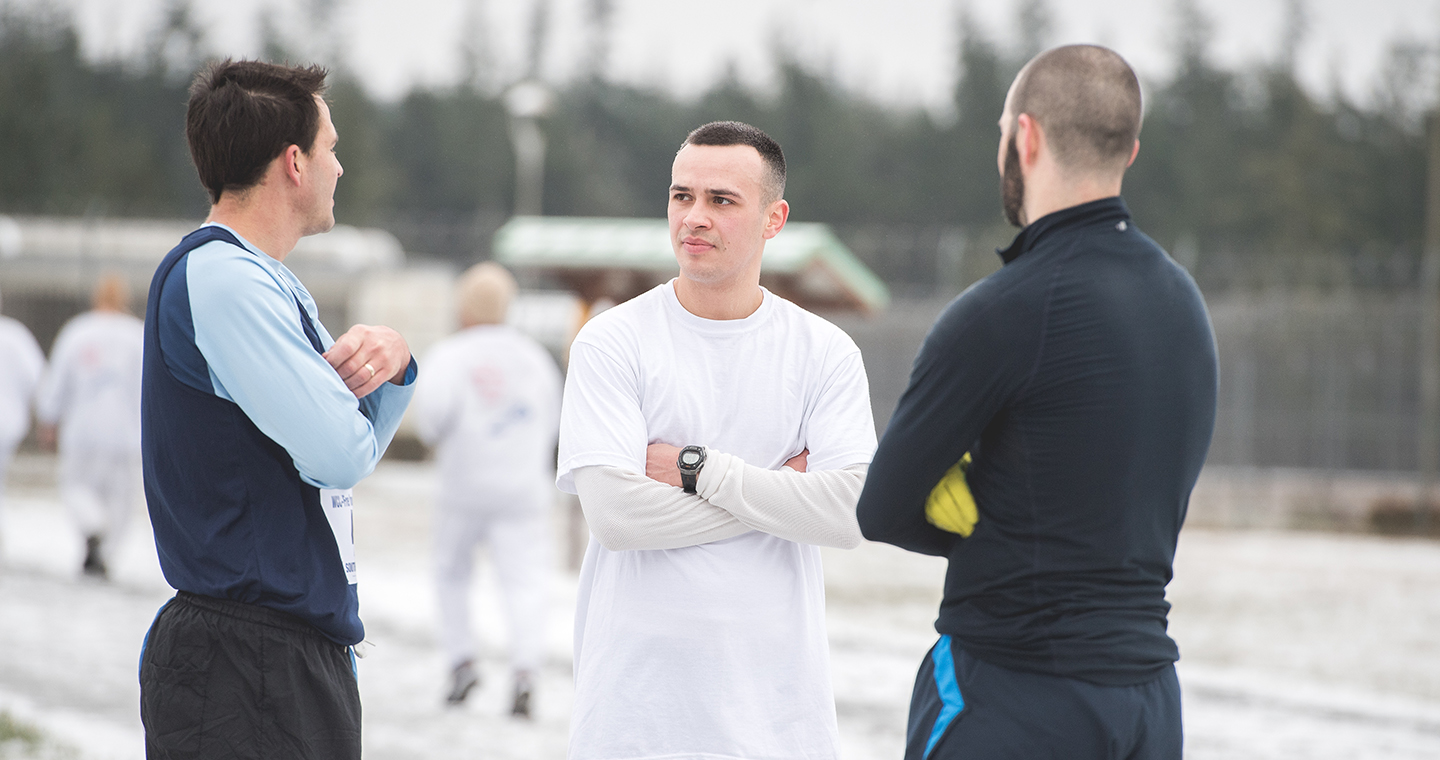
The first official US prison-inmate run club programme began at Oregon State Penitentiary in the early 1970s, spearheaded by legendary runner Steve Prefontaine.
While no official statistics are kept by the Department of Corrections, at least eight other running clubs exist at men’s and women’s prisons throughout North America. Those who volunteer to coach incarcerated populations hope that number will grow after the pandemic, considering all the emotional and mental health benefits of running.
*****
Washington Corrections Center houses a “big yard,” which has a loose gravel, quarter-mile track, and a “small yard,” a narrow dirt track less than a quarter of a mile in length. Both are surrounded by tall chain-link fencing rimmed with barbed wire. Each week, inmates are given designated yard time, depending on their job, classification and time served.
Emily Hammargren began teaching community college courses at WCC in 2010. Originally from the Midwest, Hammargren, a slight, 45-year-old with long brown hair and a wide smile, had hoped to start a running club at WCC and reached out to Ruona for advice. But the process kept stalling, owing to administrative red tape and a lack of support.
Twenty-six-year-old WCC inmate Elisha Tabor, who worked as a teaching assistant for one of Hammargren’s classes, arrived at WCC in 2011. Raised as a Jehovah’s Witness, Tabor’s parents had never allowed him to participate in organised sports, including running. At WCC, Tabor avoided team sports, opting to run alone.
The first time he ran at WCC, Tabor sprinted at full speed. He was exhausted after only a few laps and wondered aloud: “Who likes running? This is crazy!” A fellow inmate, a veteran of several marathons, was also jogging on the yard. He walked up to Tabor. “Pace yourself,” he said, showing him how to run at a steady clip. After a few laps, Tabor declared that they were running too slow. “Well, this is what you do,” the inmate responded. “This is running.”
Hammargren finally received permission to start a club in May 2017. A dozen inmates sat inside the prison gym, listening to Hammargren, Missy Farr – a DoC specialist and co-volunteer organiser – and the prison’s recreation director. Hammargren opened by asking each inmate why they wanted to run with the club. Then they headed outside.
The run club had to practice during general yard time, but the small yard’s dirt track was barely wide enough for two people to stand side-by-side. If two or three non-running club inmates were walking together, runners had to sidestep around them, often through puddles, mud and gravel pits. The runners ran in their prison-issued sneakers – white New Balance “runners” – although a few club members had purchased running shoes from the inmate catalogue. They typically wore their prison-issue white undershirt, T-shirts, shorts or sweatpants.
Despite their lack of gear, as the runners moved through their first workout, “it was an emotional experience because it was finally going,” remembers Tabor. “I’d been hopeful for it for years. We were all out here, like, ‘Is this real?’”
Hammargren introduced training plans, and a local store, South Sound Running, donated pairs of gently used shoes. Frank Ruona travelled from California to visit the run club, hosting a demonstration on the big yard.
One runner who listened intently to Ruona’s tutorial was Benito Reyes. Growing up in Mexico, Reyes was a distance runner. He served in the Army before moving to the United States, where he met his wife. He found a job managing an orchard but, arriving before sunrise and leaving after sunset each day, he found little time to run.
When he arrived at WCC in 2014, Reyes, who is 5’8,” was close to 200 pounds and hadn’t run for 15 years. In August 2017, aged 38, he joined the club, initially to get healthy and to lose weight. But as time passed, Reyes craved running. As soon as yard time began, he’d immediately start running, not stopping until an alarm or the conclusion of yard time forced him to stop.
Reyes, whose black hair is cut in a military-style buzz and who speaks in a soft murmur, says: “When you run, you free your mind – you’re not thinking about what is going on around you.”
While he was imprisoned, Reyes’s daughter died in a car accident, aged just 12. When she was alive and she was free, the two played soccer together almost every day. As he ran on the WCC yard, Reyes imagined his daughter cheering: “Go, Papi, go!”
“She is always there in my mind, pushing me,” he says, emotion halting his voice.
By September 2019 the club had grown to almost 100 members. One cool, rainy morning, 65 of them gathered on the large yard in order to attempt either 5km or the inaugural WCC half-marathon. Runners checked in at long cardboard tables set up under a makeshift tent. As the clouds settled overhead, a light drizzle started to fall. Inmates’ race bibs, printed and sponsored by South Sound Running, displayed their numbers and the text: “WCC – Free Your Mind.”
Three outside runners had been permitted to run alongside the club members, including Jesse Stevick, a chemistry teacher and cross-country coach at a nearby high school, and 65-year-old Barb Bumann, who had learned about the running club through a community group and wanted to share her own experiences of the rehabilitative power of the sport.
Bumann – short and slim, with the build of an Olympic distance runner – had discovered running almost 30 years earlier while recovering from drug and alcohol abuse. “That’s when I learned how important it is to replace bad habits with good habits,” she says.
Bumann ran alongside several of the club’s fastest runners, including Tabor, who was paced by Stevick in the 5km. Jason (last name withheld) and 22-year-old Gustavo Allen traded the lead in the early laps of the half-marathon.
Tabor and Stevick won the 5km in 31m33s, sprinting across the imaginary finish line and high-fiving before stretching together on the field.
A makeshift water table sat empty for the first 20 minutes. “I need some water!” called a runner, wiping sweat from his forehead with his T-shirt. But it was closer to half an hour when a correctional officer emerged from the main building, carrying a large cooler with water and small plastic cups.
After multiple lead swaps, Gustavo and Jason crossed the finish line almost simultaneously, finishing the half-marathon in 1h33m07s.
Reyes placed third in 1h38m04s. As he crossed the line, he grinned, high-fiving Allen and Tabor as he bent over to catch his breath. Finishers cheered each inmate as he logged another lap. Some ran solo, grimacing as they jogged; others paired up and waved at the cheering section under the tent. The rain stopped after an hour, replaced by a cool, misty breeze.
“What I loved was the guys were all so supportive, cheering each other on, cheering me on,” Bumann says. “All the men I talked to were so appreciative that we’re here. I think it brings a sense of normalcy, and I think that’s extremely important.”
Prison policy forbade Hammargren from handing out medals or pins to the finishers; instead, she supplied ribbons for the top finishers and printed and laminated a small “WCC Half-Marathon Finisher” emblem, drawn in black pen on white paper, for all of those who completed the race. She also printed certificates for club members, whom she honoured as the group stood in a circle post-race.
By late 2019, the WCC run club had become so popular that the Department of Corrections mandated that it downsize. The remaining 60 members re-branded as the WCC 1,000-Mile Running Group, also known as The Running Group.
“I asked one [inmate],” says Stevick, “If you could tell high school students anything, what would you tell them?” “He said, ‘If you are doing something wrong, it will eventually catch up with you, so expect that.’ I love it, because they are so honest about the fact that they’ve screwed up and deserve what they’ve got – and they want to make the best of it. And running is great for that.”
While no official statistics are kept by the Department of Corrections, at least eight other running clubs exist at men’s and women’s prisons throughout North America. Those who volunteer to coach incarcerated populations hope that number will grow after the pandemic, considering all the emotional and mental health benefits of running.
*****
Washington Corrections Center houses a “big yard,” which has a loose gravel, quarter-mile track, and a “small yard,” a narrow dirt track less than a quarter of a mile in length. Both are surrounded by tall chain-link fencing rimmed with barbed wire. Each week, inmates are given designated yard time, depending on their job, classification and time served.
Emily Hammargren began teaching community college courses at WCC in 2010. Originally from the Midwest, Hammargren, a slight, 45-year-old with long brown hair and a wide smile, had hoped to start a running club at WCC and reached out to Ruona for advice. But the process kept stalling, owing to administrative red tape and a lack of support.
Twenty-six-year-old WCC inmate Elisha Tabor, who worked as a teaching assistant for one of Hammargren’s classes, arrived at WCC in 2011. Raised as a Jehovah’s Witness, Tabor’s parents had never allowed him to participate in organised sports, including running. At WCC, Tabor avoided team sports, opting to run alone.
The first time he ran at WCC, Tabor sprinted at full speed. He was exhausted after only a few laps and wondered aloud: “Who likes running? This is crazy!” A fellow inmate, a veteran of several marathons, was also jogging on the yard. He walked up to Tabor. “Pace yourself,” he said, showing him how to run at a steady clip. After a few laps, Tabor declared that they were running too slow. “Well, this is what you do,” the inmate responded. “This is running.”
Hammargren finally received permission to start a club in May 2017. A dozen inmates sat inside the prison gym, listening to Hammargren, Missy Farr – a DoC specialist and co-volunteer organiser – and the prison’s recreation director. Hammargren opened by asking each inmate why they wanted to run with the club. Then they headed outside.
The run club had to practice during general yard time, but the small yard’s dirt track was barely wide enough for two people to stand side-by-side. If two or three non-running club inmates were walking together, runners had to sidestep around them, often through puddles, mud and gravel pits. The runners ran in their prison-issued sneakers – white New Balance “runners” – although a few club members had purchased running shoes from the inmate catalogue. They typically wore their prison-issue white undershirt, T-shirts, shorts or sweatpants.
Despite their lack of gear, as the runners moved through their first workout, “it was an emotional experience because it was finally going,” remembers Tabor. “I’d been hopeful for it for years. We were all out here, like, ‘Is this real?’”
Hammargren introduced training plans, and a local store, South Sound Running, donated pairs of gently used shoes. Frank Ruona travelled from California to visit the run club, hosting a demonstration on the big yard.
One runner who listened intently to Ruona’s tutorial was Benito Reyes. Growing up in Mexico, Reyes was a distance runner. He served in the Army before moving to the United States, where he met his wife. He found a job managing an orchard but, arriving before sunrise and leaving after sunset each day, he found little time to run.
When he arrived at WCC in 2014, Reyes, who is 5’8,” was close to 200 pounds and hadn’t run for 15 years. In August 2017, aged 38, he joined the club, initially to get healthy and to lose weight. But as time passed, Reyes craved running. As soon as yard time began, he’d immediately start running, not stopping until an alarm or the conclusion of yard time forced him to stop.
Reyes, whose black hair is cut in a military-style buzz and who speaks in a soft murmur, says: “When you run, you free your mind – you’re not thinking about what is going on around you.”
While he was imprisoned, Reyes’s daughter died in a car accident, aged just 12. When she was alive and she was free, the two played soccer together almost every day. As he ran on the WCC yard, Reyes imagined his daughter cheering: “Go, Papi, go!”
“She is always there in my mind, pushing me,” he says, emotion halting his voice.
By September 2019 the club had grown to almost 100 members. One cool, rainy morning, 65 of them gathered on the large yard in order to attempt either 5km or the inaugural WCC half-marathon. Runners checked in at long cardboard tables set up under a makeshift tent. As the clouds settled overhead, a light drizzle started to fall. Inmates’ race bibs, printed and sponsored by South Sound Running, displayed their numbers and the text: “WCC – Free Your Mind.”
Three outside runners had been permitted to run alongside the club members, including Jesse Stevick, a chemistry teacher and cross-country coach at a nearby high school, and 65-year-old Barb Bumann, who had learned about the running club through a community group and wanted to share her own experiences of the rehabilitative power of the sport.
Bumann – short and slim, with the build of an Olympic distance runner – had discovered running almost 30 years earlier while recovering from drug and alcohol abuse. “That’s when I learned how important it is to replace bad habits with good habits,” she says.
Bumann ran alongside several of the club’s fastest runners, including Tabor, who was paced by Stevick in the 5km. Jason (last name withheld) and 22-year-old Gustavo Allen traded the lead in the early laps of the half-marathon.
Tabor and Stevick won the 5km in 31m33s, sprinting across the imaginary finish line and high-fiving before stretching together on the field.
A makeshift water table sat empty for the first 20 minutes. “I need some water!” called a runner, wiping sweat from his forehead with his T-shirt. But it was closer to half an hour when a correctional officer emerged from the main building, carrying a large cooler with water and small plastic cups.
After multiple lead swaps, Gustavo and Jason crossed the finish line almost simultaneously, finishing the half-marathon in 1h33m07s.
Reyes placed third in 1h38m04s. As he crossed the line, he grinned, high-fiving Allen and Tabor as he bent over to catch his breath. Finishers cheered each inmate as he logged another lap. Some ran solo, grimacing as they jogged; others paired up and waved at the cheering section under the tent. The rain stopped after an hour, replaced by a cool, misty breeze.
“What I loved was the guys were all so supportive, cheering each other on, cheering me on,” Bumann says. “All the men I talked to were so appreciative that we’re here. I think it brings a sense of normalcy, and I think that’s extremely important.”
Prison policy forbade Hammargren from handing out medals or pins to the finishers; instead, she supplied ribbons for the top finishers and printed and laminated a small “WCC Half-Marathon Finisher” emblem, drawn in black pen on white paper, for all of those who completed the race. She also printed certificates for club members, whom she honoured as the group stood in a circle post-race.
By late 2019, the WCC run club had become so popular that the Department of Corrections mandated that it downsize. The remaining 60 members re-branded as the WCC 1,000-Mile Running Group, also known as The Running Group.
“I asked one [inmate],” says Stevick, “If you could tell high school students anything, what would you tell them?” “He said, ‘If you are doing something wrong, it will eventually catch up with you, so expect that.’ I love it, because they are so honest about the fact that they’ve screwed up and deserve what they’ve got – and they want to make the best of it. And running is great for that.”
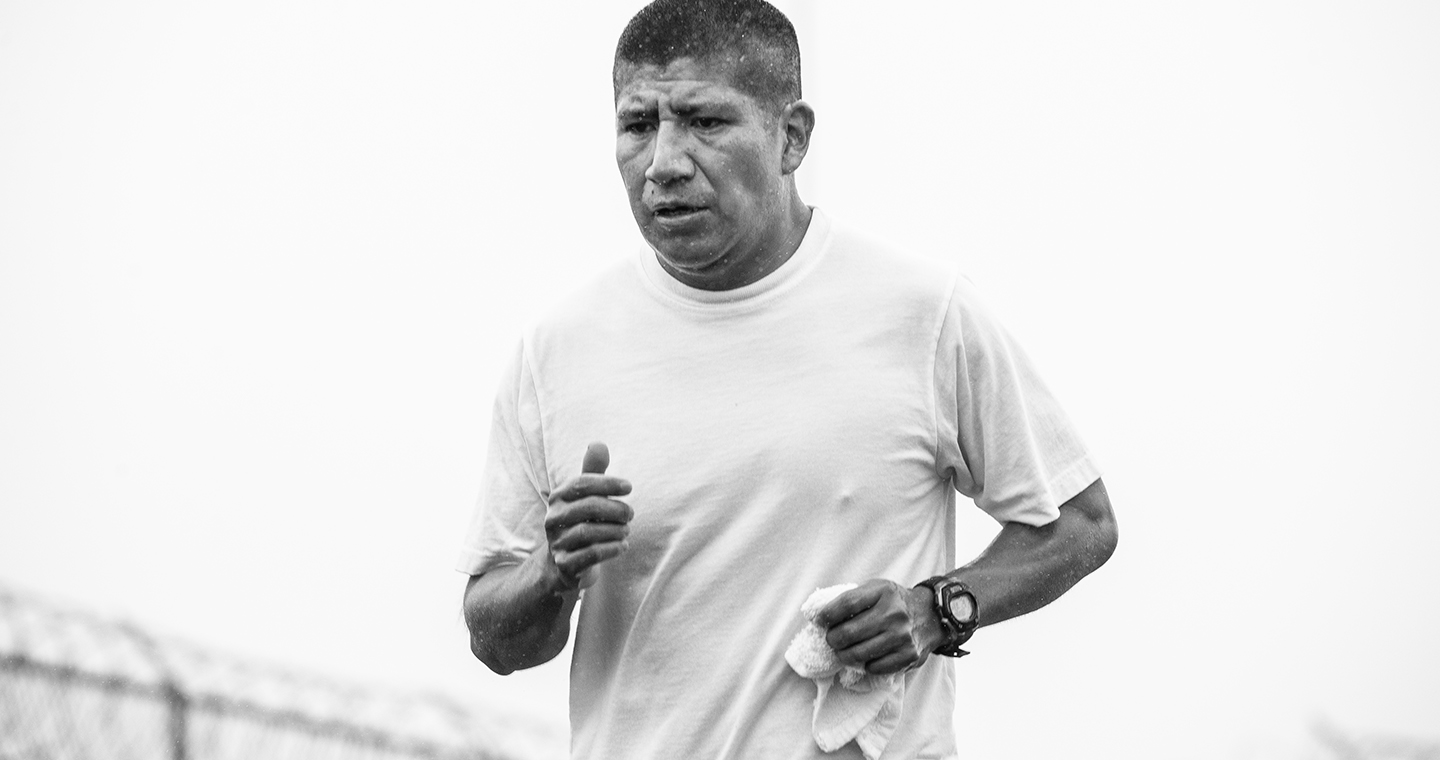
“when you run, you free your mind – you’re not thinking about what is going on around you.”
-benito reyes, washington corrections center.
-benito reyes, washington corrections center.
Bureaucratic and administrative hurdles are the main reason more volunteer-led prison run clubs don’t exist. WCC’s club took five years to come together; the Washington Corrections Center for Women’s (WCCW) programme took seven.
“The red tape is a huge part of it, as well as finding people who can coach and who are consistent,” Alexa Martin, one of WCCW running club volunteer coaches, says. “And just figuring out how to tailor something like this behind bars.”
WCCW’s prison gym has four treadmills; inmates say that fights have almost broken out over competition for usage during their limited allotted time. Despite the failure of previous attempts to start a running club, inmate and lifelong runner Nicole McCaslin, sentenced to nine years in 2014, tried again in June 2018. She enlisted WCCW Correctional Officer Kelly Luck as the staff sponsor and Sergeant Roger Afalava to help oversee the group. Seven months later, the DoC cleared the club to launch a pilot, 12-week trial, with the end goal of completing 5km on the prison yard.
Luck emailed local running coach Martin, asking if she would volunteer. On 4 January 2019, 15 inmates on the minimum-security campus awaited her arrival for their first 7am practice. Sergeant Luck and other officers shovelled snow off the path. An officer with a Fitbit walked the yard and discerned that five-and-a-quarter laps equalled one mile.
More than 60 women had expressed interest in joining the club, but the DoC limited the roster to 15. Some had never run before; others, like McCaslin, were seasoned runners.
Martin remembers that first conversation with the inmates. “It was just totally impassive faces,” she says. “It was the dead of winter, very dark outside, and I was like: ‘OK. Am I reaching them? Do they actually want to be here?’”
Martin explained the “five gears of running” programme she had created to help each runner complete 5km over 12 weeks. Then, the group started to jog.
“I almost cried from joy,” McCaslin, who is petite with long brown hair, said of the first practice. “It was so freeing to be outside in the early morning, and to just be running.” The group ran to an area of the yard they typically weren’t allowed to access; from there, they paused, looking over the mountain at a view they had never seen before.
After the inaugural practice, several members thanked McCaslin for her perseverance in starting the club. “I have never felt so good,” one inmate told her.
The group followed Martin’s weekly training programme, running in pairs at 7am on Mondays, Fridays and Sundays. Runs were abruptly cancelled if the fog was too thick or when inmate counts took too long. Most women ran in prison-issue shoes, and many struggled with plantar fasciitis and calf issues. Most of the women didn’t have a supportive sports bra or running gear.
Forty-year-old Lacey Wheeler had applied to join the club, despite never having run before. She wanted an activity that would hold her accountable, she said, particularly during the cold winter months.
“Now, I crave running,” Wheeler says, almost a year later. “It’s changed my thinking: the way I eat, how I live and how I want to be.”
In March 2019, the group ran its inaugural 5km. Martin was allowed to bring in a clock timer, and each runner was permitted one inmate to encourage her and count her laps. Inmates who weren’t allowed on the yard watched and cheered from their cell windows. Every group member finished the race.
Following the initial 12-week program, WCCW officers conducted an informal participant survey. Although the data couldn’t be used in an official capacity because it hadn’t been officially DoC evaluated, inmates reported sleeping better, improved handling of stress, and fewer experiences of anger and frustration.
Luck also noted that the running club had changed the opinions of staff members toward the inmates. “In the beginning, when I’d come in in the mornings, they’d say ‘Why are you here?’” she remembers. “When I’d tell them, they’d say, ‘Who thought that was a good idea?’ But now, they are supportive, because these women have done it well and we haven’t had any problems.”
McCaslin, who was scheduled for work release January 2020, said that she hoped to revisit the running trails near her former home.
“I am sure I will cry when I run a race on the outside,” McCaslin said in November 2019. “It will feel like true freedom. I can run in my own clothes, not having to look at razor wire or fences, and to not be thinking about that moment. Because I think about that moment a lot.”
“The red tape is a huge part of it, as well as finding people who can coach and who are consistent,” Alexa Martin, one of WCCW running club volunteer coaches, says. “And just figuring out how to tailor something like this behind bars.”
WCCW’s prison gym has four treadmills; inmates say that fights have almost broken out over competition for usage during their limited allotted time. Despite the failure of previous attempts to start a running club, inmate and lifelong runner Nicole McCaslin, sentenced to nine years in 2014, tried again in June 2018. She enlisted WCCW Correctional Officer Kelly Luck as the staff sponsor and Sergeant Roger Afalava to help oversee the group. Seven months later, the DoC cleared the club to launch a pilot, 12-week trial, with the end goal of completing 5km on the prison yard.
Luck emailed local running coach Martin, asking if she would volunteer. On 4 January 2019, 15 inmates on the minimum-security campus awaited her arrival for their first 7am practice. Sergeant Luck and other officers shovelled snow off the path. An officer with a Fitbit walked the yard and discerned that five-and-a-quarter laps equalled one mile.
More than 60 women had expressed interest in joining the club, but the DoC limited the roster to 15. Some had never run before; others, like McCaslin, were seasoned runners.
Martin remembers that first conversation with the inmates. “It was just totally impassive faces,” she says. “It was the dead of winter, very dark outside, and I was like: ‘OK. Am I reaching them? Do they actually want to be here?’”
Martin explained the “five gears of running” programme she had created to help each runner complete 5km over 12 weeks. Then, the group started to jog.
“I almost cried from joy,” McCaslin, who is petite with long brown hair, said of the first practice. “It was so freeing to be outside in the early morning, and to just be running.” The group ran to an area of the yard they typically weren’t allowed to access; from there, they paused, looking over the mountain at a view they had never seen before.
After the inaugural practice, several members thanked McCaslin for her perseverance in starting the club. “I have never felt so good,” one inmate told her.
The group followed Martin’s weekly training programme, running in pairs at 7am on Mondays, Fridays and Sundays. Runs were abruptly cancelled if the fog was too thick or when inmate counts took too long. Most women ran in prison-issue shoes, and many struggled with plantar fasciitis and calf issues. Most of the women didn’t have a supportive sports bra or running gear.
Forty-year-old Lacey Wheeler had applied to join the club, despite never having run before. She wanted an activity that would hold her accountable, she said, particularly during the cold winter months.
“Now, I crave running,” Wheeler says, almost a year later. “It’s changed my thinking: the way I eat, how I live and how I want to be.”
In March 2019, the group ran its inaugural 5km. Martin was allowed to bring in a clock timer, and each runner was permitted one inmate to encourage her and count her laps. Inmates who weren’t allowed on the yard watched and cheered from their cell windows. Every group member finished the race.
Following the initial 12-week program, WCCW officers conducted an informal participant survey. Although the data couldn’t be used in an official capacity because it hadn’t been officially DoC evaluated, inmates reported sleeping better, improved handling of stress, and fewer experiences of anger and frustration.
Luck also noted that the running club had changed the opinions of staff members toward the inmates. “In the beginning, when I’d come in in the mornings, they’d say ‘Why are you here?’” she remembers. “When I’d tell them, they’d say, ‘Who thought that was a good idea?’ But now, they are supportive, because these women have done it well and we haven’t had any problems.”
McCaslin, who was scheduled for work release January 2020, said that she hoped to revisit the running trails near her former home.
“I am sure I will cry when I run a race on the outside,” McCaslin said in November 2019. “It will feel like true freedom. I can run in my own clothes, not having to look at razor wire or fences, and to not be thinking about that moment. Because I think about that moment a lot.”
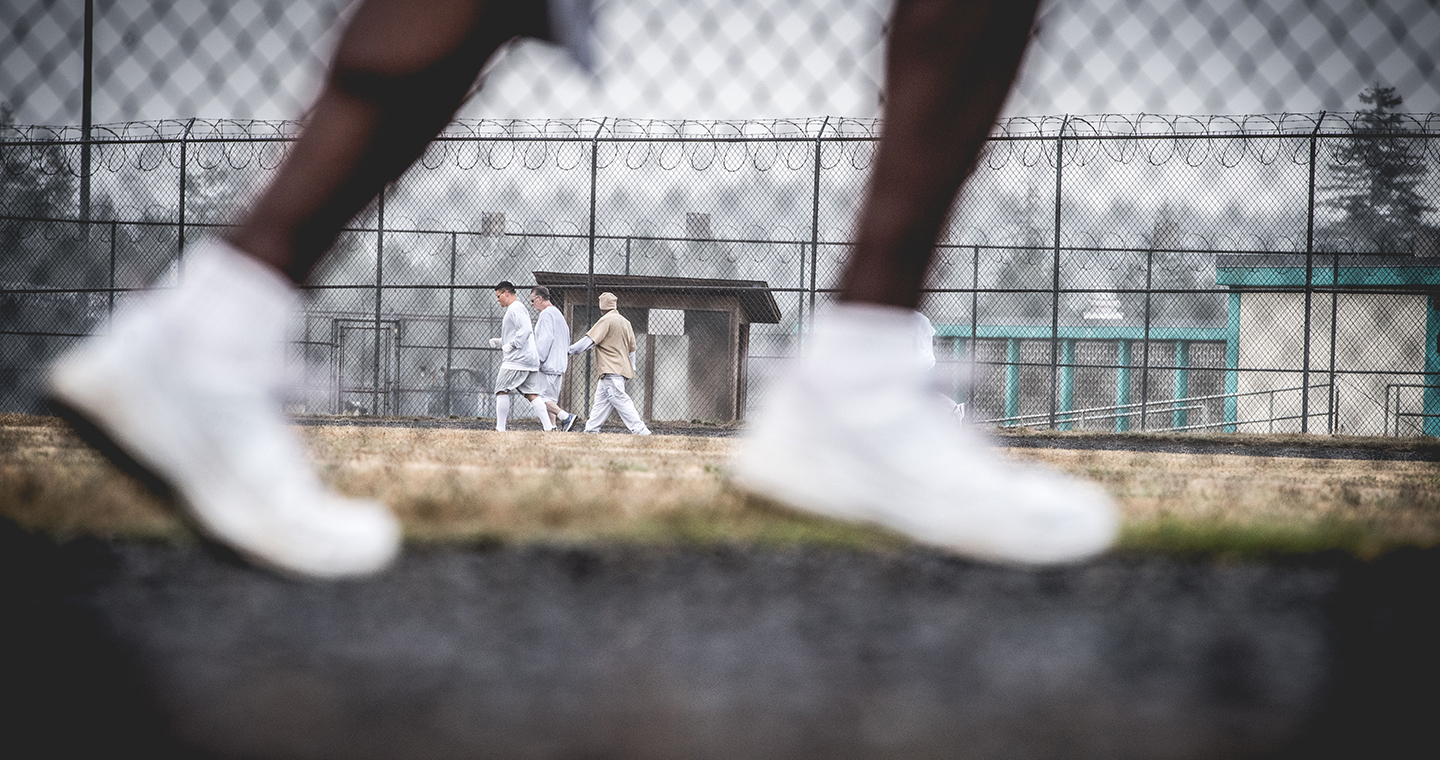
In 2012, Tim Alderson began a study at Hiland Mountain Correctional Center in Eagle River, Alaska, a minimum-security prison for women. Working toward his MSc in Counselling Psychology from Alaska Pacific University, Alderson’s research, which was unpublished and not peer-reviewed, examined the impact of a structured running programme on female prison inmates.
Over 12 weeks, Lisa Keller, owner of Multi-Sport Training of Alaska, and other volunteer coaches trained the group for a 5km race. Alderson interviewed the runners afterwards: 25 women had started the programme; 21 finished. (Of the other four, two were given early release dates and two were placed in segregation for drug offences.)
Physically, the inmates reported increased stamina, better sleep, and weight loss (collectively, they lost 46lbs). Members spoke of improved moods, less anxiety and better concentration.
Statistically, close to 80% of inmates enter the US prison system with either a depression or anxiety diagnosis, for which they are often medicated. Four inmates reported discontinuing their mental health medication, which they attributed to their participation in the running group.
Alderson’s research led him to help launch Running Free Alaska, which provides coaching to Hiland inmates through weekly training sessions, plus running-related support to the women after their release.
“We believe that the simplicity of running helps people live their best lives,” their mission statement reads. “Our vision is to create a supportive environment for women who are incarcerated and stand as a bridge to an interconnected community not defined by labels and stigmas.”
During the group’s October 2019 fall half-marathon, Hiland inmate Gina Virgilio set a course record, finishing in 1h44m03s. Two weeks later, Virgilio sat in a courthouse for her sentencing hearing. Several run club coaches spoke on her behalf, including Keller. Keller remembers that the judge told the courtroom he had never seen someone guilty of such a heinous crime who had so much community support. Nor had he seen someone who had changed so much in the time since she was incarcerated.
News of Running Free’s success spread: an officer at Spring Creek Correctional Center in Seward, Alaska, a maximum-security prison for men, began a running club. The Topeka Correctional Facility for Women in Kansas, also began a volunteer-led Running Free program, where run club members hold races within the facility to raise funds for local community programmes and non-profits. Prior to the pandemic, they had raised more than US$35,000.
But not everyone is successful at receiving approval to start a prison running club. Janalee Bell-Boychuk, deputy warden at Stony Mountain Institution in Manitoba, Canada. She began the paperwork process but there were hurdles to overcome and many stakeholders to win round, in addition to the basic challenges of proper shoes, health services, facilities etc.
“As a runner, I see the value in so many things, whether it’s the physical or mental benefit,” Bell-Boychuk says. “We have a high population of indigenous offenders and diabetes is so common amongst that group, so what a great way to control that. And mentally, running is cheaper than therapy – it’s a good opportunity to clear your head.”
She is still hoping to start a running club at Stony Mountain.
Over 12 weeks, Lisa Keller, owner of Multi-Sport Training of Alaska, and other volunteer coaches trained the group for a 5km race. Alderson interviewed the runners afterwards: 25 women had started the programme; 21 finished. (Of the other four, two were given early release dates and two were placed in segregation for drug offences.)
Physically, the inmates reported increased stamina, better sleep, and weight loss (collectively, they lost 46lbs). Members spoke of improved moods, less anxiety and better concentration.
Statistically, close to 80% of inmates enter the US prison system with either a depression or anxiety diagnosis, for which they are often medicated. Four inmates reported discontinuing their mental health medication, which they attributed to their participation in the running group.
Alderson’s research led him to help launch Running Free Alaska, which provides coaching to Hiland inmates through weekly training sessions, plus running-related support to the women after their release.
“We believe that the simplicity of running helps people live their best lives,” their mission statement reads. “Our vision is to create a supportive environment for women who are incarcerated and stand as a bridge to an interconnected community not defined by labels and stigmas.”
During the group’s October 2019 fall half-marathon, Hiland inmate Gina Virgilio set a course record, finishing in 1h44m03s. Two weeks later, Virgilio sat in a courthouse for her sentencing hearing. Several run club coaches spoke on her behalf, including Keller. Keller remembers that the judge told the courtroom he had never seen someone guilty of such a heinous crime who had so much community support. Nor had he seen someone who had changed so much in the time since she was incarcerated.
News of Running Free’s success spread: an officer at Spring Creek Correctional Center in Seward, Alaska, a maximum-security prison for men, began a running club. The Topeka Correctional Facility for Women in Kansas, also began a volunteer-led Running Free program, where run club members hold races within the facility to raise funds for local community programmes and non-profits. Prior to the pandemic, they had raised more than US$35,000.
But not everyone is successful at receiving approval to start a prison running club. Janalee Bell-Boychuk, deputy warden at Stony Mountain Institution in Manitoba, Canada. She began the paperwork process but there were hurdles to overcome and many stakeholders to win round, in addition to the basic challenges of proper shoes, health services, facilities etc.
“As a runner, I see the value in so many things, whether it’s the physical or mental benefit,” Bell-Boychuk says. “We have a high population of indigenous offenders and diabetes is so common amongst that group, so what a great way to control that. And mentally, running is cheaper than therapy – it’s a good opportunity to clear your head.”
She is still hoping to start a running club at Stony Mountain.
“I am sure I will cry when I run a race on the outside. it will feel like true freedom. I can run in my own clothes, not having to look at razor wire or fences, and to not be thinking about that moment. because I think about that moment a lot.”
-nicole mccaslin, washington corrections center for women
-nicole mccaslin, washington corrections center for women
As the clock in the 2019 San Quentin Marathon read 53m33s, the first prison-wide alarm sounded. During an alarm, inmates have to lay on the ground, motionless, until the all-clear is given. The runners sprawled out on the dirt. Frank Ruona timed the alarm’s length with a stopwatch, so he could subtract the duration from the finish times. One minute 18 seconds later, the runners stood and resumed the race.
After 1h20m, a steady rain started falling. Markelle Taylor, who had covered the first five miles at 6m38s/mile, ran intently and stared straight ahead, as Ruona, sitting in a folding chair and shivering in a black rain jacket, yelled Taylor’s split times.
When Taylor hit the half at 1h30s, Ruona handed him a GU packet. “What is this?” Taylor said. Salt beaded on his forehead, leaving streaks of white on his face and temples as he resumed running.
Nicola Bucci, 46, wore a grey knitted hat and headphones as he alternated running a lap, walking a lap. A military veteran, culinary school graduate and former competitive swimmer, Bucci had arrived at San Quentin in 2014.
“It hurts a lot when I run,” Bucci says, referencing two ACL reconstructions on his right knee, an ACL reconstruction on his left knee and bone fusions in the C5 and C6 vertebrae in his neck. “But it’s a reminder to tap back into the pain that I’ve caused a lot of other people.”
Bucci had been imprisoned in 2008 following a second-degree murder conviction. “When I run, I escape,” Bucci says. “I’m running here, but it doesn’t feel like you’re in a prison. It’s a way you can be outside of your head.”
Ruona had fixed red “DANGER” tape as the finish line; Taylor sprinted across, the tape flapping against the strong wind and driving rain, as Ruona called out: “Three hours, 10 minutes and 42 seconds!”
“Are you serious?” Taylor asked, shaking his head as salt dripped down his face. He had beaten his own record by just over six minutes.
He moved to the side of the track before stepping into a pair of prison-issue sweatpants and putting a dry sweatshirt and beanie on over his rain-and-sweat-soaked clothes. “I think it helped me not running during the fires and the lockdowns,” Taylor said. “I also run better in the cold.”
Twenty minutes later, Ruona walked over and reminded Taylor to stretch, as second-place finisher Mark Jarosik crossed the line in 3h31m45s. Jarosik, 51, had arrived at San Quentin the previous May, his most recent stop in 10 years of incarceration. A former architect, he had competed in triathlons but had never attempted a marathon until that day.
Ultimately, 23 runners completed the 2018 San Quentin marathon, a 1,000-Mile Club record. The oldest finisher, 71-year-old Mike Keeyes, crossed his fourth San Quentin finish line in 4h50m47s, becoming the first 70-year-old finisher in the race’s history.
One of the final finishers was 61-year-old Lee “Timbuktu” Goins. Lanky and tall, wearing dark running shorts and a tank top, Goins had battled injury throughout the marathon, but danced a little jig after he crossed the line, rain pouring down. Spots of blood were visible on his shorts, but he was smiling and laughing after completing his fourth San Quentin marathon in close to five-and-a-half hours.
A New Orleans native, Goins always loved to run. “I’m married to it,” he says. “It’s like a high. I’m floating with gravity.” In the early 1980s, before he was incarcerated, Goins was shot in his right hip. Doctors told him that he wouldn’t be able to run again following his surgery. “I said: “Man, you lost your mind!’” he laughs.
When he runs, Goins often feels intense pain at his wound spot. Following the marathon, medics stretchered him to the prison hospital; he was released later that night. “I tell people: “If it ain’t hurting, you ain’t gaining nothing,’” Goins says.
Goins entered the prison system in October 1987, reaching San Quentin in November 2012. While he had run independently during yard time at each prison, he had never experienced a running club until San Quentin.
“It’s been wonderful,” Goins says. “[Without the club] I don’t think I’d be alive right now. I really don’t. I’m not into no drugs, I ain’t with none of that stuff. This life is so messed up in here, but I’m always free when I’m running. My mind is not here.”
After finishing the marathon, several runners drank water and briefly stretched before putting on their prison-issue denim jackets and walking off toward their assigned jobs. Some returned to their cells for a shower before their work assignment; others didn’t have time, so they headed straight there, across the yard in soaked shoes.
After 1h20m, a steady rain started falling. Markelle Taylor, who had covered the first five miles at 6m38s/mile, ran intently and stared straight ahead, as Ruona, sitting in a folding chair and shivering in a black rain jacket, yelled Taylor’s split times.
When Taylor hit the half at 1h30s, Ruona handed him a GU packet. “What is this?” Taylor said. Salt beaded on his forehead, leaving streaks of white on his face and temples as he resumed running.
Nicola Bucci, 46, wore a grey knitted hat and headphones as he alternated running a lap, walking a lap. A military veteran, culinary school graduate and former competitive swimmer, Bucci had arrived at San Quentin in 2014.
“It hurts a lot when I run,” Bucci says, referencing two ACL reconstructions on his right knee, an ACL reconstruction on his left knee and bone fusions in the C5 and C6 vertebrae in his neck. “But it’s a reminder to tap back into the pain that I’ve caused a lot of other people.”
Bucci had been imprisoned in 2008 following a second-degree murder conviction. “When I run, I escape,” Bucci says. “I’m running here, but it doesn’t feel like you’re in a prison. It’s a way you can be outside of your head.”
Ruona had fixed red “DANGER” tape as the finish line; Taylor sprinted across, the tape flapping against the strong wind and driving rain, as Ruona called out: “Three hours, 10 minutes and 42 seconds!”
“Are you serious?” Taylor asked, shaking his head as salt dripped down his face. He had beaten his own record by just over six minutes.
He moved to the side of the track before stepping into a pair of prison-issue sweatpants and putting a dry sweatshirt and beanie on over his rain-and-sweat-soaked clothes. “I think it helped me not running during the fires and the lockdowns,” Taylor said. “I also run better in the cold.”
Twenty minutes later, Ruona walked over and reminded Taylor to stretch, as second-place finisher Mark Jarosik crossed the line in 3h31m45s. Jarosik, 51, had arrived at San Quentin the previous May, his most recent stop in 10 years of incarceration. A former architect, he had competed in triathlons but had never attempted a marathon until that day.
Ultimately, 23 runners completed the 2018 San Quentin marathon, a 1,000-Mile Club record. The oldest finisher, 71-year-old Mike Keeyes, crossed his fourth San Quentin finish line in 4h50m47s, becoming the first 70-year-old finisher in the race’s history.
One of the final finishers was 61-year-old Lee “Timbuktu” Goins. Lanky and tall, wearing dark running shorts and a tank top, Goins had battled injury throughout the marathon, but danced a little jig after he crossed the line, rain pouring down. Spots of blood were visible on his shorts, but he was smiling and laughing after completing his fourth San Quentin marathon in close to five-and-a-half hours.
A New Orleans native, Goins always loved to run. “I’m married to it,” he says. “It’s like a high. I’m floating with gravity.” In the early 1980s, before he was incarcerated, Goins was shot in his right hip. Doctors told him that he wouldn’t be able to run again following his surgery. “I said: “Man, you lost your mind!’” he laughs.
When he runs, Goins often feels intense pain at his wound spot. Following the marathon, medics stretchered him to the prison hospital; he was released later that night. “I tell people: “If it ain’t hurting, you ain’t gaining nothing,’” Goins says.
Goins entered the prison system in October 1987, reaching San Quentin in November 2012. While he had run independently during yard time at each prison, he had never experienced a running club until San Quentin.
“It’s been wonderful,” Goins says. “[Without the club] I don’t think I’d be alive right now. I really don’t. I’m not into no drugs, I ain’t with none of that stuff. This life is so messed up in here, but I’m always free when I’m running. My mind is not here.”
After finishing the marathon, several runners drank water and briefly stretched before putting on their prison-issue denim jackets and walking off toward their assigned jobs. Some returned to their cells for a shower before their work assignment; others didn’t have time, so they headed straight there, across the yard in soaked shoes.
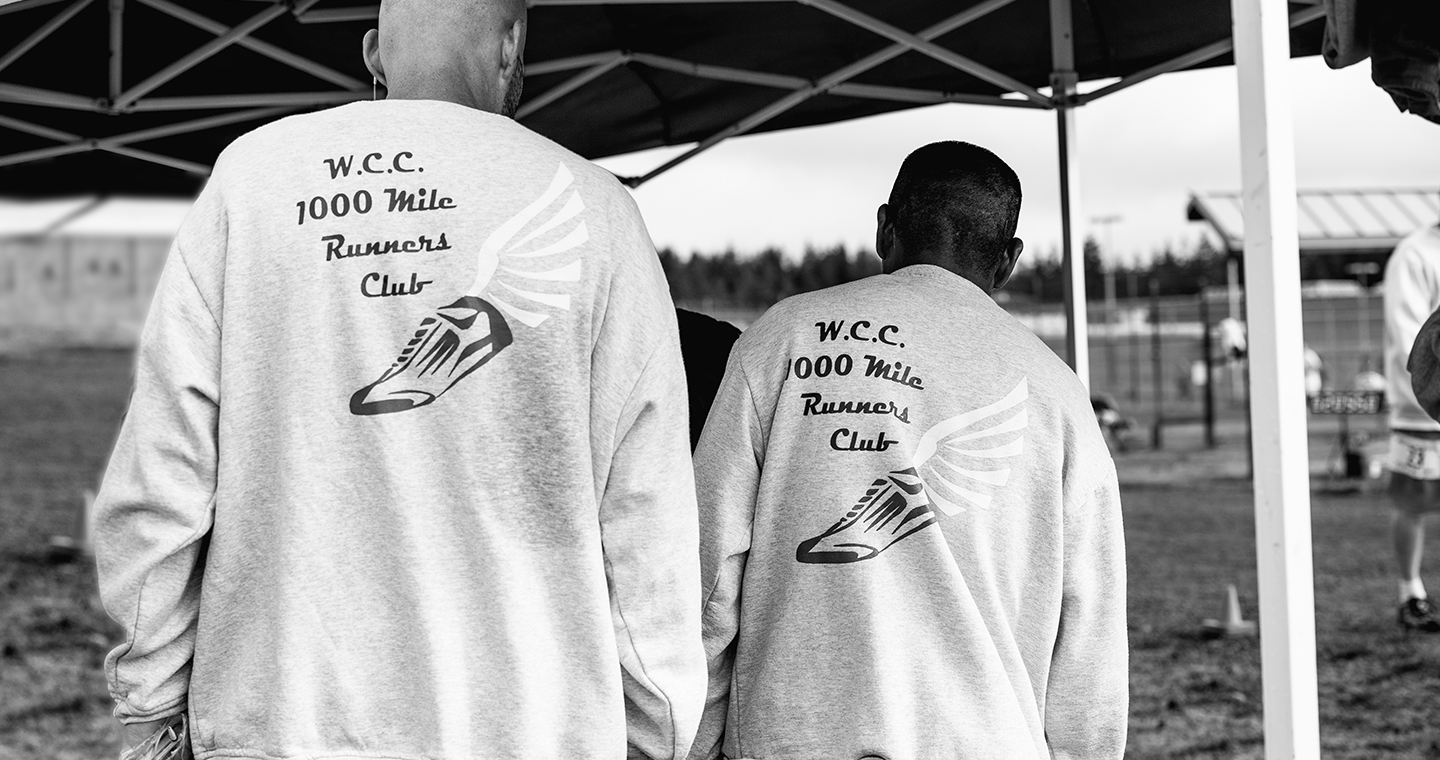
Edward Moses had never run further than six miles when he arrived at San Quentin in March 2018. But as he watched Ruona and the other volunteer coaches print race results, offer instruction and record individual statistics, he wanted to join the club.
By July 2018, he had completed the early fall half-marathon, finishing in last in 2h14m. Moses, then 46, set a goal to run the full marathon in November. But the wildfires delayed the date, and Moses was paroled in December. “I told everyone, I may not get to run this marathon, but I will run the Los Angeles Marathon,” Moses says.
When Moses arrived in transitional housing in Riverside County, he reached out to the Skid Row Running Club to continue his training. But he realised that between housing, transportation and trying to find a job, he couldn’t afford the marathon entrance fee. He contacted the 1,000-Mile Running Club coaches, who stepped in with the money.
“It’s hard to get started [on the outside],” Moses says. “Transportation, work and housing – I call them the big three. You’re able-bodied and willing to work, but a lot of opportunities aren’t there for you. It would’ve been easy for me to say: ‘I have too much going on to run and train.’ It’s motivating to see myself sticking with this goal, even though I’m faced with these transitional challenges.”
Moses ran the 2019 Los Angeles Marathon – he had targeted 3h55m, but calf pain slowed him down and he crossed the line in 5h 45m.
“Running long distances isn’t easy, but when you pass milestones and you improve, it’s really, really invigorating,” Moses says. “It gives you the feeling like, OK, if I can run a half-marathon or 20 miles, shit, I can do anything if I put my mind to it and work at it.
“I’ll tell you – I don’t really love running. But I love the results afterward.”
By July 2018, he had completed the early fall half-marathon, finishing in last in 2h14m. Moses, then 46, set a goal to run the full marathon in November. But the wildfires delayed the date, and Moses was paroled in December. “I told everyone, I may not get to run this marathon, but I will run the Los Angeles Marathon,” Moses says.
When Moses arrived in transitional housing in Riverside County, he reached out to the Skid Row Running Club to continue his training. But he realised that between housing, transportation and trying to find a job, he couldn’t afford the marathon entrance fee. He contacted the 1,000-Mile Running Club coaches, who stepped in with the money.
“It’s hard to get started [on the outside],” Moses says. “Transportation, work and housing – I call them the big three. You’re able-bodied and willing to work, but a lot of opportunities aren’t there for you. It would’ve been easy for me to say: ‘I have too much going on to run and train.’ It’s motivating to see myself sticking with this goal, even though I’m faced with these transitional challenges.”
Moses ran the 2019 Los Angeles Marathon – he had targeted 3h55m, but calf pain slowed him down and he crossed the line in 5h 45m.
“Running long distances isn’t easy, but when you pass milestones and you improve, it’s really, really invigorating,” Moses says. “It gives you the feeling like, OK, if I can run a half-marathon or 20 miles, shit, I can do anything if I put my mind to it and work at it.
“I’ll tell you – I don’t really love running. But I love the results afterward.”
“now, I crave running. it’s changed my thinking: the way I eat, how I live and how I want to be.”
-lacey wheeler, washington corrections center for women.
-lacey wheeler, washington corrections center for women.
The evening after the 2018 marathon San Quentin held its’ annual sports banquet inside the prison chapel. Members of the baseball, basketball and other sports teams took turns standing on the stage, thanking the volunteers and awarding certificates and medals.
Tommy Wickerd, who had completed his third San Quentin Marathon earlier that day, walked to the stage before handing awards to Maloney and fellow volunteer coach Diana Fitzpatrick. He spoke of the hours of work that the coaches had put into training the inmates. He talked about the run club members’ improved pace, mental health, and the sense of family that the 1,000-Mile Club had built. He thanked Ruona, whom, he said, was a father figure and mentor to club members.
Just before the group stepped off the stage, Wickerd looked out again at the crowd, motioning to the volunteer coaches.
“Thank you,” he said, “for seeing us as humans.”
Tommy Wickerd, who had completed his third San Quentin Marathon earlier that day, walked to the stage before handing awards to Maloney and fellow volunteer coach Diana Fitzpatrick. He spoke of the hours of work that the coaches had put into training the inmates. He talked about the run club members’ improved pace, mental health, and the sense of family that the 1,000-Mile Club had built. He thanked Ruona, whom, he said, was a father figure and mentor to club members.
Just before the group stepped off the stage, Wickerd looked out again at the crowd, motioning to the volunteer coaches.
“Thank you,” he said, “for seeing us as humans.”
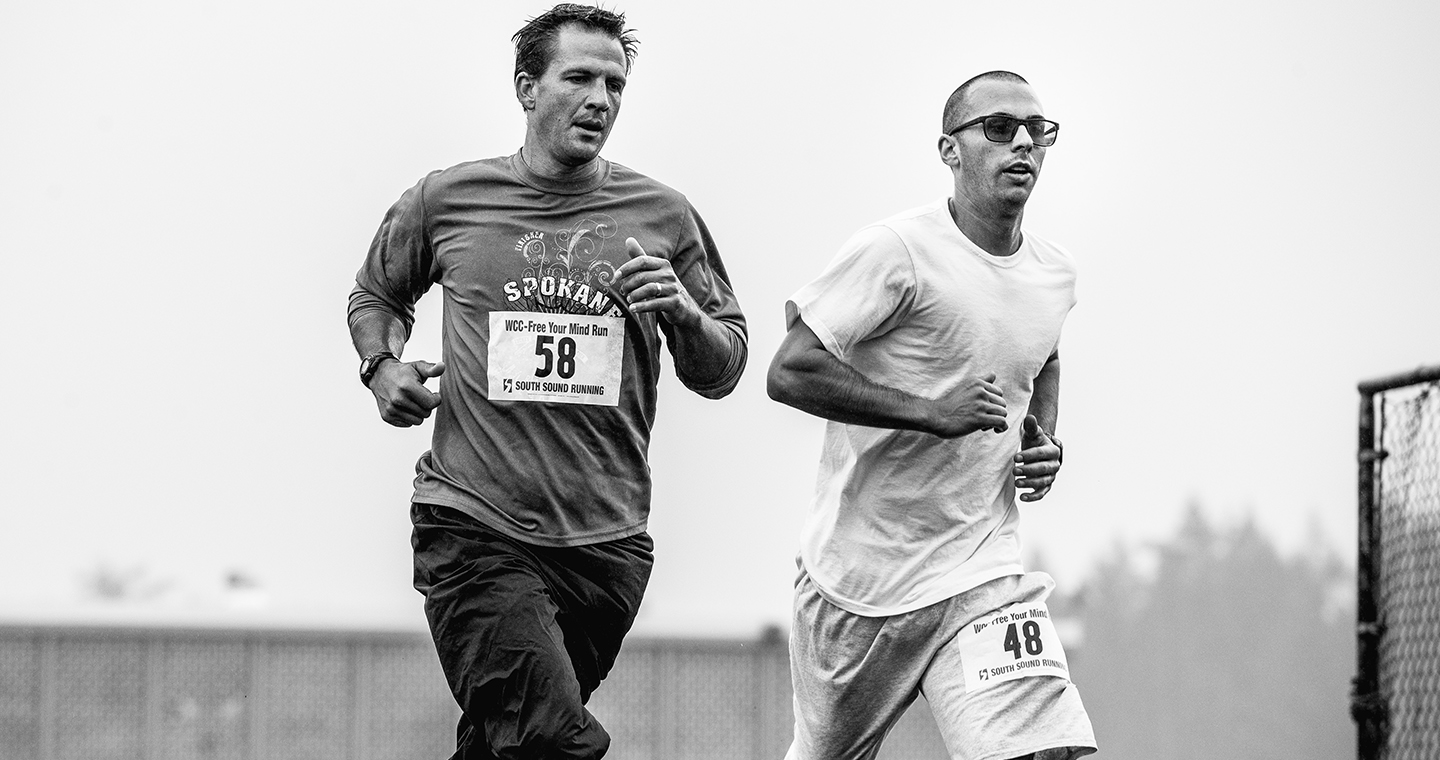
volunteer jesse stevick running with elisha tabor
EPILOGUE
On Friday 13 March 2020, Ruona led the San Quentin 1,000-Mile Club through its usual workout. The group was scheduled to run a six-mile race the following Friday.
But then, the pandemic abruptly stopped life as they knew it. San Quentin officials shut down the prison to the outside world on 16 March. Ruona and the other volunteers have not been allowed inside since. Ruona wrote in an email that for most of 2020, inmates: “have not been doing much–other than sitting in their cells the bulk of their time.”
Hiland volunteer coaches have not been inside the prison since 11 March 2020, and Keller anticipates them not being allowed inside until possibly 2022. The gym has been closed since the start of the pandemic, and the women are usually locked down.
Since the start of the pandemic, 965 WCC inmates had contracted Covid-19. WCCW has fared much better overall, with only 12 confirmed cases. While Martin was not allowed inside the prison, she reported that WCCW runners continued to train, led by Lacey Wheeler.
San Quentin did not fare as well: in May 2020, more than 120 inmates were transferred from the California Institution for Men in Chino, following several Covid-19 outbreaks. By the end of August, the Los Angeles Times reported that 2,237 San Quentin inmates subsequently tested positive in the largest outbreak in the country at the time; 27 inmates and one staff member died from the virus.
Ruona reports that as of January 2021, inmates are gradually being given yard time again, albeit only with those who reside on their cell block, and only for a limited amount of time. “It is my hope that once we get the San Quentin population vaccinated, we may be able to return to the prison by mid-2021,” Ruona emailed. “That is just a hope. Who knows what will happen?”
Markelle Taylor was released from San Quentin in March 2019. 45 days later, he finished the Boston Marathon in 3h03m52s. Currently living in the San Francisco area and working for Ruona’s former employer, he has continued training with the Tamalpa Runners club. He hopes to break a three-hour marathon.
Lee Goins was released in March 2019. That June, he ran the famed Dipsea trail race. He resides in the San Francisco area, and he has continued his running with Tamalpa. He is working full-time while also taking online classes toward his college degree. He hopes to become a chef.
Benito Reyes was released to an Immigration Detention Center in Tacoma, Washington on 9 January 2020 – the last time Hammargren heard from him. He was deported to Mexico, where he had aspirations of running a marathon.
Elisha Tabor is expected to be released from WCC on 18 April 2027. He does not know where he will live or what he will be doing – but he knows that he will run.
On Friday 13 March 2020, Ruona led the San Quentin 1,000-Mile Club through its usual workout. The group was scheduled to run a six-mile race the following Friday.
But then, the pandemic abruptly stopped life as they knew it. San Quentin officials shut down the prison to the outside world on 16 March. Ruona and the other volunteers have not been allowed inside since. Ruona wrote in an email that for most of 2020, inmates: “have not been doing much–other than sitting in their cells the bulk of their time.”
Hiland volunteer coaches have not been inside the prison since 11 March 2020, and Keller anticipates them not being allowed inside until possibly 2022. The gym has been closed since the start of the pandemic, and the women are usually locked down.
Since the start of the pandemic, 965 WCC inmates had contracted Covid-19. WCCW has fared much better overall, with only 12 confirmed cases. While Martin was not allowed inside the prison, she reported that WCCW runners continued to train, led by Lacey Wheeler.
San Quentin did not fare as well: in May 2020, more than 120 inmates were transferred from the California Institution for Men in Chino, following several Covid-19 outbreaks. By the end of August, the Los Angeles Times reported that 2,237 San Quentin inmates subsequently tested positive in the largest outbreak in the country at the time; 27 inmates and one staff member died from the virus.
Ruona reports that as of January 2021, inmates are gradually being given yard time again, albeit only with those who reside on their cell block, and only for a limited amount of time. “It is my hope that once we get the San Quentin population vaccinated, we may be able to return to the prison by mid-2021,” Ruona emailed. “That is just a hope. Who knows what will happen?”
Markelle Taylor was released from San Quentin in March 2019. 45 days later, he finished the Boston Marathon in 3h03m52s. Currently living in the San Francisco area and working for Ruona’s former employer, he has continued training with the Tamalpa Runners club. He hopes to break a three-hour marathon.
Lee Goins was released in March 2019. That June, he ran the famed Dipsea trail race. He resides in the San Francisco area, and he has continued his running with Tamalpa. He is working full-time while also taking online classes toward his college degree. He hopes to become a chef.
Benito Reyes was released to an Immigration Detention Center in Tacoma, Washington on 9 January 2020 – the last time Hammargren heard from him. He was deported to Mexico, where he had aspirations of running a marathon.
Elisha Tabor is expected to be released from WCC on 18 April 2027. He does not know where he will live or what he will be doing – but he knows that he will run.
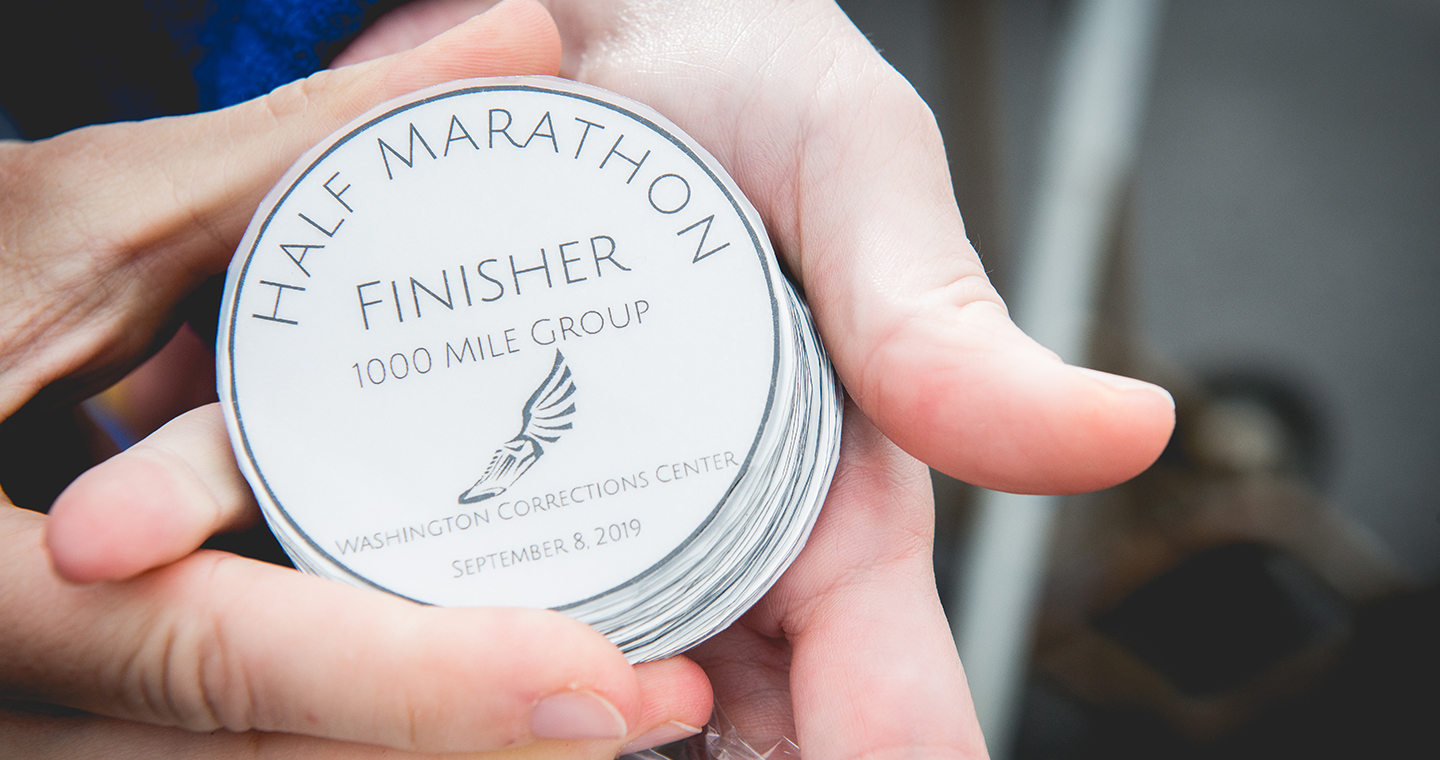
more articles




